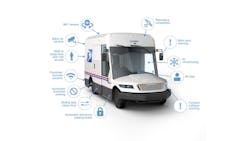“Trade ya,” I said, like we were 10 or 11 years old and looking for a different bagged lunch in the school cafeteria or, in this case, looking to swap for a different set of chores.
I was mowing the yard, which was the most productive thing I could think to do, rather than try to make up 600 words to fill this page.
Normally, being asked to mow would’ve sent me directly to my desk, muttering something about deadlines to my wife as I closed the study door. But, just a few minutes earlier, with a legitimate deadline looming, I’d been at my desk looking out the window on a warm spring afternoon and saw that the weeds had sprouted. I got right on the task I didn’t immediately need to tend to.
Then my mailman—or letter carrier, or whatever the proper title is these days—drove up, and it was with him I offered to swap duties for the afternoon.
“You don’t want my job today,” he said. “No air conditioning in this old truck.”
He was driving the Postal Service’s ubiquitous white box van, doors open from March to November down South. It’s officially the Grumman Long Life Vehicle, a design that’s been in service since 1987—so it’s lived up to its name (congrats, I guess, to USPS maintenance shops).
“Well, I’ve got good news and bad news,” I said. “Fancy new electric trucks are coming, but I just saw that their delivery has delayed.”
TBB readers might recall that, a little more than a year ago, Oshkosh closed an initial $3 billion order for 50,000 next-generation delivery vehicles (NGDVs). Those trucks were to be on the road by this fall. Then environmental groups started screaming that these ICE-powered vehicles needed to be electric—indeed, a postal route was an ideal application for an electric commercial vehicle—and eventually several states got together to sue to block the deal over environmental concerns. EVs, however, could alleviate those concerns.
But EVs aren’t cheap, so Congress kicked in another $3 billion for the electric trucks and charging infrastructure, and Oshkosh committed to making three out of four NGDVs electric. But that’s going to take more time. USPS will update the court in June as to the delivery schedule, according to a recent filing.
So back to my letter carrier. Of course, he knows what I do and what I read—since he puts copies of TBB and FleetOwner and Fleet Maintenance and Construction Equipment in my mailbox every month.
“Tell me about the good news, then,” he said.
I briefly described several electric step vans I’ve had my hands on (Canada Post recently signed an order for a Morgan-built version), and all of the bells and whistles that could be included, such as climate-controlled driver comfort zones and advanced driver assistance safety technologies.
“My truck doesn’t even have air bags,” he said as he pulled, traveling 50 ft. to the house next door.
And I went back to my lawnmower. Lori bought a small electric mower when we downsized. It is cordless, light, and quiet. It has a sensor of some sort that increases the power and blade speed if the grass is thick. So, unless I’ve let the weeds get out hand, I can get through the front and back on a single charge. The trimmer and blower are also electric, and share a battery. They’re also immensely more quiet (though less powerful) than my previous gasoline tools. But I don’t have to beat back the wilderness like I had to at our old house. I can wear shorts and not bleed.
Electric tools are the future. If they’re spec’d properly for the application, they’re pretty good now. Options are good; mandates, not so much.
Still, don't let the EV hype get in the way of a sound business decision—either way.
About the Author
Kevin Jones
Editor
Kevin has served as editor-in-chief of Trailer/Body Builders magazine since 2017—just the third editor in the magazine’s 60 years. He is also editorial director for Endeavor Business Media’s Commercial Vehicle group, which includes FleetOwner, Bulk Transporter, Refrigerated Transporter, American Trucker, and Fleet Maintenance magazines and websites.
Working from Beaufort, S.C., Kevin has covered trucking and manufacturing for nearly 20 years. His writing and commentary about the trucking industry and, previously, business and government, has been recognized with numerous state, regional, and national journalism awards.

